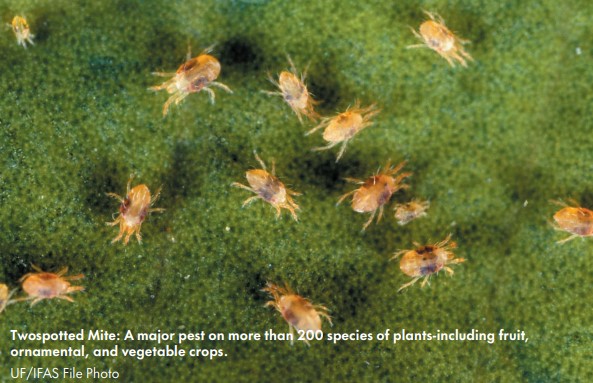by LUIS RODRIGUEZ
In Florida, many organisms are plant pests. Among these are arthropods. Arthropods include a vast group including centipedes, millipedes, spiders, mites, horseshoe crabs, scorpions, insects, and crustaceans. Not all arthropods are pests, but those that are pests could cause serious problems to our crops if not controlled properly. The most common arthropod pests are insects, but there is a group that is often confused with insects, and sometimes control methods are wrongly performed. These are mites.
Mites vs Insects
Mites are not insects. While insects have 3 body parts (head, thorax, and abdomen) and 6 legs, mites have 2 body parts (a head and a thorax infused with the abdomen) and 8 legs. Mites are more related to spiders than insects. Knowing this is important because regular insecticides will not affect mites. Growers will need to use a miticide to control mites. There are broad-spectrum insecticides that also have miticidal activity, but regular insecticides do not target mites. It is the responsibility of the grower to verify what products control mites to have proper control of these pests.
What Are Spider Mites and How Growers Can Identify Them?
Spider mites are among the most important agricultural pests of many plants. Although spider mites are arthropods, as mentioned before, they are not insects. Like spiders, these mites generate a thin webbing on the plants they infest (that’s the reason they are called spider mites). Spider mites are small red arthropods (0.8mm) that look like red spots on top of the plant leaves and the webbing they generate.
Spider mite infestations occur commonly in dry and hot weather. A typical life cycle of spider mites comprises 4 stages: egg, larva, nymphs (protonymph and deutonymph), and adult. They undergo gradual metamorphosis, meaning the larvae and nymphs look like mini versions of the adults (but without their reproductive capacities), although one difference between adults and larvae is that the larva stage only has 3 pairs of legs instead of 4. The females deposit the eggs on the webbing they generate, and it takes approximately 3 days for these eggs to hatch. The length of the cycle will vary depending on temperature, but under optimal conditions (approximately 80°F) the cycle can be completed within 5 – 20 days.
Spider Mite Damage
Like other arthropods, spider mites have a piercing-sucking mouthpart. Their mouth is like a straw-like structure that pierces through plants to extract plant sap. This can cause yellow or discolored spots on the leaf surface, could also cause a decrease in photosynthesis, and a premature drop in the leaves. Some species of spider mites are also vectors of plant diseases. In severe infestations, spider mites can cause plant death when not properly controlled.
How Can Growers Control Spider Mites?
Growers should develop an Integrated Pest Management (IPM) program to control spider mites. There are several methods growers can use in combination to control these pests:
Monitoring – Monitoring spider mites is extremely important, especially when trying to avoid confusing them with insects. Using a 10X magnifying lens could be efficient in identifying these arthropods. If you do not see mites specifically, observing any cast skins or webbing could be an indication of their presence. Growers should always check the underside of plant leaves since this is where some mites may be hiding. Acting before an infestation happens could help growers to save money and avoid unnecessary plant damage. On large farms, monitor selected plants representing the total of acres under production and estimate the amounts of mites to determine if control is needed. A good practice is to take a white paper, place it under the plant leaves, shake it, and count how many mites fall into the paper. This could give you an idea of how many mites could be infesting other plants on your farm.
Biological Control – When we talk about biological control we are referring to natural predators of a specific pest. There are plenty of natural predators of spider mites. These include lady beetles, lacewings, bigeye bugs, minute pirate bugs, and predatory mites, among others. Having this species around your crops may help maintain the mite population under control. If you are depending on biological control, when using pesticides, try to use products less harmful to the predatory species of mites.
Chemical Control – Chemical control refers to the use of pesticides. There are plenty of pesticides designed to control mites. Remember that mites are not insects, so insecticides are not effective when controlling mites unless the product functions as a broad-spectrum insecticide that also has miticidal activity. The label is the law and is also the first set of instructions on how to use a product, so growers should always read the label of any pesticide to be used to verify if mites are listed as species controlled by the product. Furthermore, mite eggs are very resistant to pesticides, so secondary applications are often needed. Read the label for proper application timing, rates, and how often these applications need to be done.
For more information on spider mites access the following “ASK IFAS” publications:
Twospotted Spider Mite, Tetranychus urticae Koch (Arachnida: Acari: Tetranychidae)
2024–2025 Florida Citrus Production Guide: Rust Mites, Spider Mites, and Other Phytophagous Mites
Mite Pests of Southern Highbush Blueberry in Florida
Luis Rodriguez is the Polk County Small Farms and Pesticide Education Extension Agent. You can reach him at lrodriguezrosado@ufl.edu.
Twospotted Mite: A major pest on more than 200 species of plants-including fruit, ornamental, and vegetable crops.
Credit/Provider: UF/IFAS File Photo
Predacious Mite, although many mites are important pests for crops and animals, there are also predacious mites that feed on pests mites.
Credit/Provider: UF/IFAS File Photo
Spider mites can generate a fine webbing where the females will lay their eggs.
Photo credit: University of Florida.

